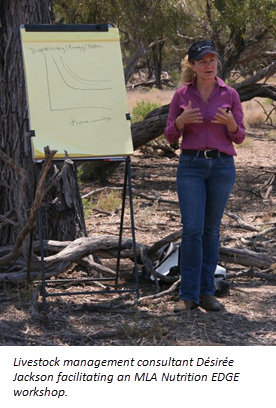Herd nutrition strategies that pay big dividends
10 September 2021

As the wet season approaches, Queensland livestock management consultant Désirée Jackson says it’s important for producers to have their finger on the pulse when it comes to nutrition to maximise the turn-off weights and overall fertility of their herd.
“With high market prices, there’s such a benefit to strategic nutritional management – the return on these investments is manyfold at the moment if it’s done correctly,” Désirée said.
“If producers get in early to make those decisions around nutrition – such as supplementation – that’s where it really pays for itself.”
As well as operating her own livestock consultancy, Désirée delivers MLA’s Nutrition EDGE workshops, hosted throughout Australia to guide producers on how they can adopt nutritional strategies to achieve their herd performance targets.
According to Désirée, the end of the dry season is a critical time for producers to be monitoring their herd’s nutrition, when feed availability and diet quality are at their lowest.
“It’s worth monitoring when there are critical changes in the diet in relation to animal requirements and what the pasture is providing - such as which nutrient becomes the primary limiting nutrient - so that producers can maximise turn-off weights, improve fertility and reduce the risk of mortalities,” Désirée said.
Four nutritional strategies Désirée recommends producers adopt to maximise productivity on-farm this spring are:
1. Monitor the availability of pasture
“It’s important to monitor how much grass there is available to make sure it will not only carry animals through, but that there will be enough residual pasture available so there’s a quick response in pasture growth at the start of the wet season,” Désirée said.
“During that period immediately after the first rain where pastures start to grow, there’s a real shortage of feed for animals – the quality is high but the quantity is low, and animals can rapidly lose weight.”
“But if people have sufficient residual pasture left over at the end of the dry season, then that will shorten up that transitional period following the break in the season, when animals are losing weight, until there’s sufficient pasture in front of them to be able to meet their daily dry matter intake requirements.”
“This will serve to minimise the weight loss experienced within the herd at this time,” Désirée said.
2. Account for supplementation
“Feeding urea or low levels of protein-based supplements can increase their animals’ pasture intake so adjustments to stock numbers to offset the increase in grazing pressure is vital,” Désirée said.
“Supplementing phosphorus where there is a deficiency and it is the most limiting nutrient in the diet will also increase pasture intake when the diet quality is good, so it is important to account for these factors when stocking paddocks to ensure there is adequate roughage to last until the break in season.”
3. Monitor diet quality
“Coming into spring in particular is a period when diet quality is lowest, and it’s generally when energy becomes deficient in a lot of classes of cattle, particularly breeders and young weaners,” Désirée said.
“At this time, producers should be looking at the diet quality of their herd to determine the gap between the dietary intake of protein, energy and phosphorus and animal nutrient requirements.”
“Diet quality testing may indicate that they need to have different nutritional strategies in place or need to feed a completely different supplement (to meet nutrient requirements).”
4. Consider spike feeding
“Another strategy worth considering is spike feeding heifers that are due to calve at the end of the dry season,” Désirée said.
“This is because they’re going to be losing considerable weight once they calve until there is sufficient green feed in front of them, due to their own requirements for growth and the increased requirements due to lactation.
“Spike feeding ensures their body condition is maintained to reduce the post-partum anoestrus period1, so heifers can resume cycling earlier and achieve higher rates of reconception.”
Footnotes
1. The postpartum anoestrus period is the period directly after calving when heifers or cows do not cycle.
|
How-to guide for optimising herd nutrition Short-term strategies for now:
Long-term strategies to consider:
|


